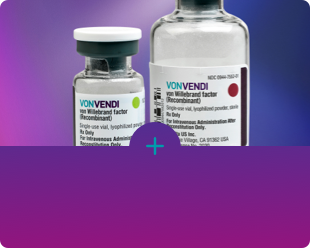


Explore safety across pivotal studies1
Indications
VONVENDI [von Willebrand factor (recombinant)] is indicated in adult and pediatric patients with von Willebrand disease (VWD) for1:
- On-demand treatment and control of bleeding episodes.
- Perioperative management of bleeding.
For adult patients only:
- Routine prophylaxis to reduce the frequency of bleeding episodes.
VONVENDI: an established safety profile1
- VONVENDI's safety profile was established in 6 clinical trials1
- VONVENDI is the first and only recombinant VWF treatment option for VWD1-5
- Recombinant products are manufactured without blood or human plasma, so there is virtually no risk of blood-borne pathogen transmission6,7
Of the 132 total study participants across 6 clinical studies, the following adverse reactions were observed: headache (n=18), vomiting (n=9), nausea (n=7), dizziness (n=4), generalized pruritus (n=3), hypertension (n=2), vertigo (n=2), tachycardia (n=1), infusion site paresthesia (n=1), chest discomfort and increased heart rate (n=1), hot flush (n=1), deep vein thrombosis (n=1), dysgeusia (n=1), tremor (n=1), electrocardiogram T wave inversions (n=1)1,8
Across all studies and age groups, no study participants developed anaphylaxis or neutralizing antibodies.1,8

Although no study participants developed anaphylaxis or neutralizing antibodies across all studies, HCPs should continue to monitor for anaphylaxis and inhibitor development.8
Pooled safety data from six clinical studies1
n (%)
Vomiting
Nausea
9 (7%)
7 (5%)
Infusion site paresthesia
Infusion-related reaction*
1 (0.8%)
1 (0.8%)
Hypertension
Hot flush
Deep vein thrombosis
2 (2%)
1 (0.8%)
1 (0.8%)
Headache
Dizziness
Vertigo
Dysgeusia
Tremor
18 (14%)
4 (3%)
2 (2%)
1 (0.8%)
1 (0.8%)
*One patient developed infusion-related reaction experiencing chest discomfort and increased heart rate.1
Read Dosing by Indication
Prophylaxis, on-demand, and perioperative dosing for VONVENDI1
Support for Your Patients
Browse a variety of resources from Takeda for your appropriate patients
Contact a Takeda Rep
Get in touch with a Takeda representative in your area
References
- VONVENDI [von Willebrand factor (Recombinant)] Prescribing Information.
- HUMATE-P [Antihemophilic Factor/von Willebrand Factor Complex (Human)] Prescribing Information. CSL Behring GmbH; 2020.
- WILATE Full Prescribing Information. Paramus, NJ: Octapharma; rev December 2023.
- ALPHANATE® (antihemophilic factor/von Willebrand factor complex [human]) Prescribing Information. Grifols.
- FDA Approves Prophylactic Treatment with VONVENDI [von Willebrand Factor (Recombinant)] for Adult Patients Living with Severe Type 3 von Willebrand Disease (VWD). Businesswire. Accessed August 14, 2025. https://www.businesswire.com/news/home/20220131005214/en/FDA-Approves-Prophylactic-Treatment-with-VONVENDI-von-Willebrand-Factor-Recombinant-for-Adult-Patients-Living-with-Severe-Type-3-von-Willebrand-Disease-VWD
- Franchini M, Mannucci PM. Von Willebrand factor (Vonvendi®): the first recombinant product licensed for the treatment of von Willebrand disease. Expert Rev Hematol. 2016;9(9):825-830.
- Turecek PL, Mitterer A, Matthiessen HP, et al. Development of a plasma- and albumin-free recombinant von Willebrand factor. Hamostaseologie. 2009;29 Suppl 1:S32-S38.
- Data on file, Takeda, Inc.



